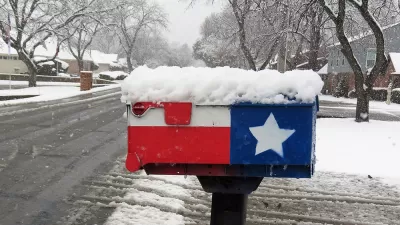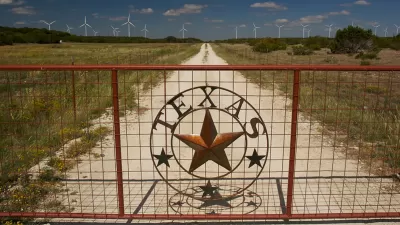The Electric Reliability Council of Texas (ERCOT), the nonprofit, independent power grid operator for 90 percent of the nation's second-largest state, has become the convenient fall guy for the epic power failure caused by an extreme weather event.

The facilitator of a media briefing (held via Webex) on Feb.17 directed a question from the Fort Worth Star-Telegram to Bill Magness, the CEO and general manager of the Electric Reliability Council of Texas (see the Austin American-Statesman video accompanying the source article):
"Gov. Greg Abbott, during an interview with a Houston TV station on Tuesday (Feb. 16) evening, said that he thinks the ERCOT response over the past couple of days was a total failure and that leadership should resign.
"What is ERCOT's response to the governor's resignation call and how do you all assess your response to this winter weather event?"
Magness was professional in his response, and as he explained during the CBS Austin interview (posted here) earlier in the day, he described the importance of implementing rotating outages rather than allowing for an even more catastrophic outcome to the electric grid. [See Texas Tribune: "Texas was 'seconds and minutes' away from catastrophic monthslong blackouts, officials say," Feb. 18.]
Rather than blaming the grid operator for what Austin American-Statesman reporter, Asher Price, called "the most calamitous week in modern Texas history," the roots of the power failure rest with the power plant owners and operators who opted not to winterize their equipment for a very simple reason – they weren't required to. And whose fault was that? [Answered below.]
Déjà vu
What's clear is that "Winter Storm 2021," as the Tribune has dubbed it, has put the performance of the nation's first independent system operator (ISO) front and center in one of the biggest natural calamities in the history of the Lone Star State.
What's less clear to many is that it was not an unprecedented event, report Price and Bob Sechler for the Statesman on Feb. 18. It was just over a decade ago that an extreme winter weather event precipitated rotating outages, though not of the same duration as last week's storm, and a near-grid collapse.
"Early on the morning of February 1, as temperatures fell and a cold wind blew, the state’s power generators started failing," wrote Eric Dexheimer for the American-Statesman on April 11, 2011, in what Sechler and Price call a post-mortem on that extreme weather event.
As more dropped off the grid, ERCOT, which is responsible for managing 85 percent of the state’s electricity, ordered companies to fire up their reserve units. When many of those stuttered [sic], too, ERCOT ordered rolling blackouts to prevent a shutdown of the grid.
ERCOT initially said a few dozen generating units had failed, then reported in late March that 152 of the system’s 550 units statewide had gone down between Feb. 1 and Feb. 4
What's remarkable about the post-mortem is that it begins with an analysis of an even earlier extreme weather event – the record freeze of late December 1989, that resulted in a report prepared by the Public Utility Commission of Texas. Referring to that report dated November 1990, Dexheimer writes:
“At the same time that demand was increasing, weather-related equipment malfunctions were causing generating units to trip off the line.” As a result, it noted, the state suffered widespread rolling blackouts and “near loss of the entire ERCOT electric grid.”
So how could the same near-collapse of the grid occur in 2011 that nearly happened 22 years earlier? Was nothing learned? Dexheimer explains:
Although state regulators are charged with overseeing many aspects of the energy market, requiring utilities to be weatherized isn’t one of them. When the [Public Utility Commission] PUC compiled its suggestions in 1990, there was nothing to make sure they would be followed.
Fast-forward 10 years (from 2011)
"You could take out ‘2011’ and pop in ‘2021,’ and there is going to be a lot of similarities" between the deficiencies in the grid found in the report 10 years ago and those plaguing it now, said Dave Tuttle, an Energy Institute research associate at the University of Texas, add Sechler and Price.
“It’s not like the technology isn’t there” to keep electricity flowing during extremely low temperatures, he said. “There are people who live in a lot colder climates than we do” without losing power.
2011 Federal report urged winterization of energy infrastructure
The "technology" that Tuttle is referring to is known as the winterization of energy infrastructure, which was among the recommendations of the "Report on Outages and Curtailments During the Southwest Cold Weather Event of February 1-5, 2011 [pdf]: Causes and Recommendations," prepared by the staffs of the Federal Energy Regulatory Commission and the North American Electric Reliability Corporation, released in August of that year.
"This report documents the information received by the [FERC/NERC joint] task force and presents the task force’s conclusions as to the causes of the electric outages and natural gas curtailments that occurred during the February 2011 event," states the introduction. From the executive summary:
The [February 2011] storm, however, was not without precedent. There were prior severe cold weather events in the Southwest in 1983, 1989, 2003, 2006, 2008, and 2010. The worst of these was in 1989, the prior event most comparable to 2011. That year marked the first time ERCOT resorted to system-wide rolling blackouts to prevent more widespread customer outages.
Causes of February 2011 electric failure:
The majority of the problems experienced by the many generators that tripped, suffered derates, or failed to start during the event were attributable, either directly or indirectly, to the cold weather itself. For the Southwest as a whole, 67 percent of the generator failures (by MWh) were due directly to weather-related causes, including frozen sensing lines, frozen equipment, frozen water lines, frozen valves, blade icing, low temperature cutoff limits, and the like.
In addition to weather-induced generator problems, the storm caused a significant drop in natural gas production in the Southwest. "These declines propagated downstream through the rest of the gas delivery chain, ultimately resulting in natural gas curtailments to more than 50,000 customers in New Mexico, Arizona, and Texas."
Under the section titled, "Winterization" [italics added]
While extreme cold weather events are obviously not as common in the Southwest as elsewhere, they do occur every few years. And when they do, the cost in terms of dollars and human hardship is considerable. The question of what to do about it is not an easy one to answer, as all preventative measures entail some cost...
This report makes a number of recommendations that the task force believes are both reasonable economically and which would substantially reduce the risk of blackouts and natural gas curtailments during the next extreme cold weather event that hits the Southwest.
Among the Key Findings and Recommendations of the 2011 Report [italics added]
- The lack of any state, regional or Reliability Standards that directly require generators to perform winterization left winter-readiness dependent on plant or corporate choices.
- While the probability of a winter event in the predominantly summer peaking Southwest appears to be low, shedding load in the winter places lives and property at risk. The task force recommends that all entities responsible for the reliability of the bulk power system in the Southwest prepare for the winter season with the same sense of urgency and priority as they prepare for the summer peak season.
- States in the Southwest should examine whether Generator/Operators ought to be required to submit winterization plans, and should consider enacting legislation where necessary and appropriate.
On that last point, Gov. Abbott deserves some credit, albeit belatedly. On Feb. 18, Abbott announced that he "is asking the Legislature to mandate the winterization of Texas' power system and for the Legislature to ensure the necessary funding for winterization."
Correspondent's note: The source article is also available on the USA TODAY network.
Related in Planetizen:
- California-Style Rolling Blackouts Come to Texas, Feb. 18, 2021
- Blog post: "Haves and Have Nots: Planning and the Deep Divides of the Pandemic" (see: "Texas is facing a fatal weather emergency..."), Feb. 17, 2021
FULL STORY: Storm blackouts plagued Texas in 2011, too. How much did energy regulators actually change?

Alabama: Trump Terminates Settlements for Black Communities Harmed By Raw Sewage
Trump deemed the landmark civil rights agreement “illegal DEI and environmental justice policy.”

Planetizen Federal Action Tracker
A weekly monitor of how Trump’s orders and actions are impacting planners and planning in America.

The 120 Year Old Tiny Home Villages That Sheltered San Francisco’s Earthquake Refugees
More than a century ago, San Francisco mobilized to house thousands of residents displaced by the 1906 earthquake. Could their strategy offer a model for the present?

Opinion: California’s SB 79 Would Improve Housing Affordability and Transit Access
A proposed bill would legalize transit-oriented development statewide.

Record Temperatures Prompt Push for Environmental Justice Bills
Nevada legislators are proposing laws that would mandate heat mitigation measures to protect residents from the impacts of extreme heat.

Downtown Pittsburgh Set to Gain 1,300 New Housing Units
Pittsburgh’s office buildings, many of which date back to the early 20th century, are prime candidates for conversion to housing.
Urban Design for Planners 1: Software Tools
This six-course series explores essential urban design concepts using open source software and equips planners with the tools they need to participate fully in the urban design process.
Planning for Universal Design
Learn the tools for implementing Universal Design in planning regulations.
Clanton & Associates, Inc.
Jessamine County Fiscal Court
Institute for Housing and Urban Development Studies (IHS)
City of Grandview
Harvard GSD Executive Education
Toledo-Lucas County Plan Commissions
Salt Lake City
NYU Wagner Graduate School of Public Service




























